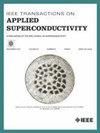铁芯气隙设计对高温超导变压器电磁行为和损耗性能的影响
IF 1.8
3区 物理与天体物理
Q3 ENGINEERING, ELECTRICAL & ELECTRONIC
引用次数: 0
摘要
在高温超导(HTS)变压器的磁芯中引入气隙可以在一定程度上缓解磁饱和,同时影响电磁性能和损耗。为了详细研究这种影响,本文建立了一个9kva三相高温超导变压器的三维有限元模型。该研究考察了气隙长度和位置的变化如何影响主磁通路径、漏场分布和相关损耗。结果表明,增大气隙长度可有效缓解磁芯局部磁饱和,磁芯损耗显著降低。然而,这也会导致在间隙边缘附近的泄漏场强度显著增加。当气隙百分比从0%增加到6%以下时,交流损耗保持在100w以下;超过8%,损失急剧上升。此外,将气隙置于堆芯翼的中心可以使交流损耗和堆芯损耗最小化。这些研究结果为优化高温超导变压器铁芯气隙设计以提高电磁性能和抑制能量损失提供了理论支持。本文章由计算机程序翻译,如有差异,请以英文原文为准。
Impact of Core Air-Gap Design on Electromagnetic Behavior and Loss Performance in High-Temperature Superconducting Transformer
Introducing air gaps into the magnetic core of high-temperature superconducting (HTS) transformers can help mitigate magnetic saturation to some extent and influence both electromagnetic performance and losses. To investigate this effect in detail, this article develops a 3-D finite element model of a 9 kVA three-phase HTS transformer. The study examines how variations in air-gap length and position affect the main magnetic flux path, leakage field distribution, and associated losses. The results show that increasing the air-gap length effectively alleviates local magnetic saturation in the core, resulting in a significant reduction in core loss. However, this also leads to a notable increase in leakage field intensity near the gap edges. When the air-gap percentage increases from 0% to below 6%, the ac loss remains under 100 W; beyond 8%, the ac loss rises sharply. Furthermore, placing the air gap at the center of the core limb minimizes both ac loss and core loss. These findings offer theoretical support for optimizing core air-gap design in HTS transformers to improve electromagnetic performance and suppress energy loss.
求助全文
通过发布文献求助,成功后即可免费获取论文全文。
去求助
来源期刊

IEEE Transactions on Applied Superconductivity
工程技术-工程:电子与电气
CiteScore
3.50
自引率
33.30%
发文量
650
审稿时长
2.3 months
期刊介绍:
IEEE Transactions on Applied Superconductivity (TAS) contains articles on the applications of superconductivity and other relevant technology. Electronic applications include analog and digital circuits employing thin films and active devices such as Josephson junctions. Large scale applications include magnets for power applications such as motors and generators, for magnetic resonance, for accelerators, and cable applications such as power transmission.
 求助内容:
求助内容: 应助结果提醒方式:
应助结果提醒方式:


